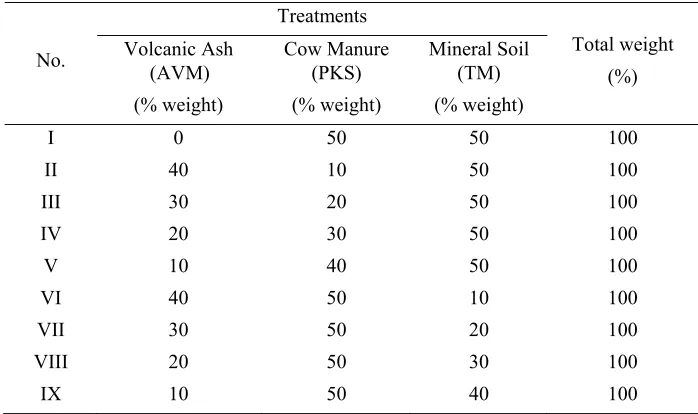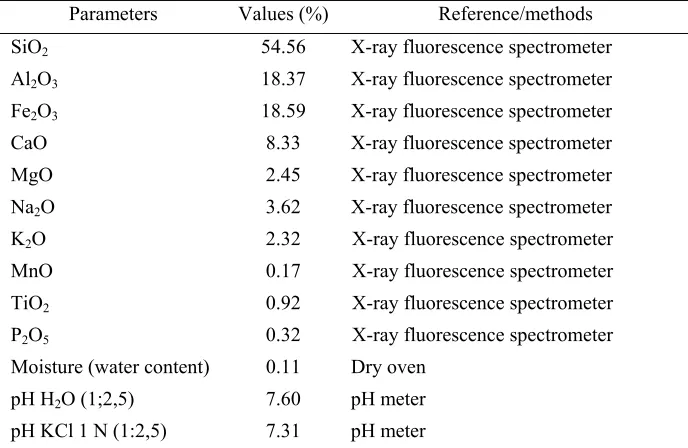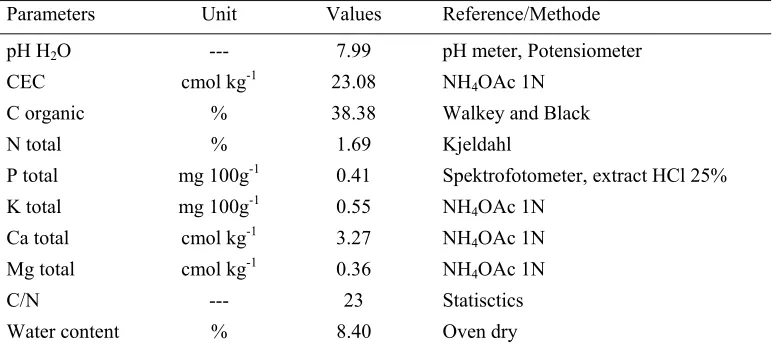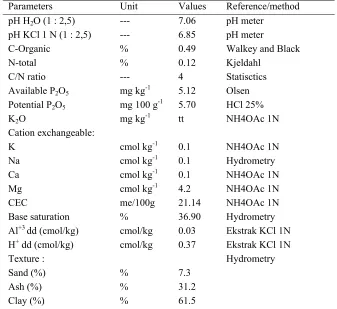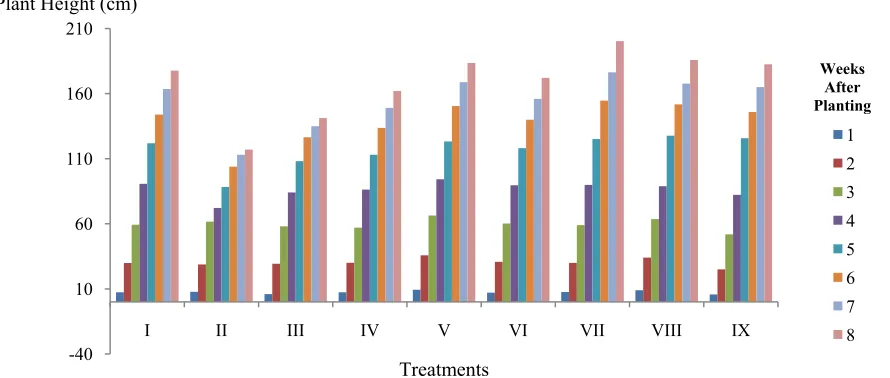Published by Canadian Center of Science and Education
Effect of Different Mixed Media (Merapi Volcanic Ash, Cow Manure
and Mineral Soil) on Chemical Properties of Soil and Growth of Maize
(
Zea mays
L.)
Abraham Suriadikusumah1, Wilman Nugraha1, Nenny Nurlaeny1 & Rina Devnita1
1
Department of Soil Science, Padjadjaran University, Jatinangor, West Java, Indonesia
Correspondence: Abraham Suriadikusumah, Department of Soil Science, Padjadjaran University, Jatinangor, West Java, Indonesia. E-mail: [email protected]
Received: September 29, 2012 Accepted: December 10, 2012 Online Published: January 15, 2013 doi:10.5539/jas.v5n2p188 URL: http://dx.doi.org/10.5539/jas.v5n2p188
Abstract
The volcanic ash can not be used as crop growth media directly due to lack of physical characteristics and low rate of plant’s nutrient. With addition of other components (elements) such as organic matter and mineral soil, this mixed media expected to empower the volcanic ash used as growth media for crops. To realize this idea, a research was done with maize as a crop indicator. This study was conducted to find out the combination effects of Merapi volcanic ash, cow manure and mineral soil on organic carbon, total N, organic matter and growth of maize (Zea mays L.). During April to July 2011, in the pot under the glass house at Faculty of Agricultural Padjadjaran University, Jatinangor-West Java at about 740 m above sea level. The experiment used a randomized block design which arranged in one factor, nine treatments and three replications. The nine treatments consisted of: 0% volcanic ash + 50% cow manure + 50% mineral soil (I), 40% volcanic ash + 10% cow manure + 50% mineral soil (II), 30% volcanic ash + 20% cow manure + 50 mineral soil (III), 20% volcanic ash + 30% cow manure + 50% mineral soil (IV), 10% volcanic ash + 40% cow manure + 50% mineral soil (V), 40% volcanic ash + 50% cow manure + 10% mineral soil (VI), 30% volcanic ash + 50% cow manure + 20% mineral soil (VII), 20% volcanic ash + 50% cow manure + 30% mineral soil (VIII), and 10% volcanic ash + 50% cow manure + 40% mineral soil (IX). The data were analyzed by using Anova Test and Duncan's Multiple Range Test. The result showed that there were significant effects of mixed media (volcanic ash, cow manure and mineral soil) on organic carbon, total N, organic matter and plant growth of maize. The highest organic carbon (4.6%) and organic matter (8.08%) was found in combination (treatment VII): 30% volcanic ash, 50% cow manure and 20% mineral soils. Combination in treatment IX: combination of 10% ash volcano, 40% cow manure and 50% mineral soil gave a significant scored on total N.
Keywords: merapi volcanic ash, cow manure, inceptisols, organic matter, maize
1. Introduction
Mount Merapi in Yogyakarta, Indonesia, is the most active volcano in the world. Until October 26, 2010, major eruptions of Mount Merapi had occurred as many as 84 times with short interval of eruptions about 2-5 years (Daryono, 2010). The composition of volcanic ash clouds that ejected by Mount Merapi comprised predominantly of silica (>50 per cent), together with smaller amounts of the oxides of aluminium, iron, calcium and sodium. In addition to volcanic ash, volcanic eruption columns also contain many gases including water vapour, sulphur dioxide, chlorine, hydrogen sulphide and oxides of nitrogen (International Civil Aviation Organization, 2007). Volcanic ash from volcanic material ejected into the air during an eruption and spread to different directions and places.
To empower the volcanic ash and other materials of eruption, is about 140 million M3, to be an agriculture or growing media in favourable condition. The volcanic ash was added by elements of cow manure and mineral soil of Inceptisols. Leaungvutivirog et al. (2002) found that application of organic fertilizers affected on increasing total bacteria, actinomycetes, fungi population, phosphorus and potassium content than chemical fertilizer addition in four soil series. Moreover, Rasoulzadeh and Yaghoubi (2010) reported that cattle manure can improved soil structure and water retention capacity by increased soil organic carbon, aggregate stability of soil, available water capacity.
Provision of cow manure is expected to improve the ability of volcanic ash by addition of organic matters and accelerate the development of the growing media, e.g., improving water holding capacity, increasing organic matter and micro-organism activities, adding soil and plant nutrients. While providing Inceptisol mineral soil will enhance the planting medium with mineral elements and absorb and holding micro and macro nutrients for plant, support the establishment of plant. Corn was used as crop indicator.
Each element or component of media has different levels in terms of quantity and formed a composition of a growing media, there were nine combinations of treatment. To see how far the effects of a combination of constituent elements of the media on several soil properties: soil organic C, soil organic matter, total N, and plant growth; the study was conducted.
2. Materials and Method
The pot experiment was conducted in glass-house at Faculty of Agriculture, Padjadjaran University Jatinangor-Indonesia, about 740 meters above sea level during April 2011 to July 2011. The treatments were different combination media of three factors : volcanic ash (taken from Somoketro village, Magelang-Central Java, ±17 km from mount Merapi at 7°37′ S - 110°18′ E) 5 weeks after eruption; cow manure and Inceptisol soil mineral at horizon B (> 50 cm of depth) taken from Jatinangor cowshed-Teaching and Research Farm, belonging to the Faculty of Agriculture, Padjadjaran University, Regency of Sumedang 6°55′ S - 107°46′ E. Each media weighted of 10 kg. There were 9 combination media as below (Table 1).
Table 1. Composition of each treatment of media
No.
Treatments
Total weight (%) Volcanic Ash
(AVM) (% weight)
Cow Manure (PKS) (% weight)
Mineral Soil (TM) (% weight)
I 0 50 50 100
II 40 10 50 100
III 30 20 50 100
IV 20 30 50 100
V 10 40 50 100
VI 40 50 10 100
VII 30 50 20 100
VIII 20 50 30 100
IX 10 50 40 100
Note: AVM = abu vulkanik merapi, PKS = pupuk kandang sapi, TM = tanah mineral
Each treatment put in one pot and replicated three times, so there were 27 pots in total. This experiment was arranged in randomized blok design. The measured soil chemical properties were organic Carbon, total N, organic matter, and plant growth; corn was plant indicator. The data analyzed by using Anova Test andDuncan's Multiple Range Test, and its Linear Model was :
Yij = μ + αj + πi + εij (1)
πi = the effect of block i (in repeated measures subjects are the blocks)
εij = experimental error
Creation of media starts with add and mixed all of 3 elements/components: merapi volcanic ash, cow manure and Inceptisol soil mineral; with proportion of each elements is according to kind of treatment. The proportion of media component is based on consideration, “what the impacts of different volcanic ash on soil chemical properties, and of course for plant or crop growth”.
Cow manure given was dry (8.4% of water content), and soil mineral was air dried with 2 mm of particles. These mixed media were incubated for 2 weeks and humidity relatively kept with sprinkling. The media was added, one week after planting, by fertilizers of urea (45% N, 1.5 g pot-1), SP-18 (18% P2O5, 2 g pot-1), and KCl (50% K2O, 1
g pot-1). The maize, var 16 Bisi with 90% of germination, sown two seeds per pot. Two weeks after planting, only one selected young plant present in the pot.
Soil chemical parameters observed and analyzed, were organic carbon, total N, and organic matter. Soil samples were collected at last vegetative stage of crop, 56 days after planting. The determination of soil organic carbon is based on the Walkley-Black (1934) chromic acid wet oxidation method. Oxidisable matter in the soil is oxidised by 1 N K2Cr2O7 solution. The reaction is assisted by the heat generated when two volumes of H2SO4 are mixed
with one volume of the dichromate. The remaining dichromate is titrated with ferrous ammonium sulphate. The titre is inversely related to the amount of C present in the soil sample.
For soil total N, the dried and homogenised material is digested in a suitable Kjeldahl tube with sulfuric acid. To rise the temperature, potassium sulfate is added and titanium di-oxide/copper sulfate is used as a catalyst. After adding sodium hydroxide to the digestion solution the produced ammonium from all nitrogen species is evaporated by distillation as ammonia. This is condensed in a conical flask with boric acid solution. The amount is titrated against indicator with sulfuric acid.
3. Results and Discussion
3.1 Chemical Properties of Volcanic Ash, Cow Manure, and Inceptisols Soil
The chemical properties and characteristics of each component of, volcanic ash, cow manure, and Inceptisols soil mineral are presented in Table 2, 3, and 4, respectively. The laboratory analysis showed that the volcanic ash has a high sand content of 70%. This causes the volcanic ash has a low water holding capacity which is shown in its water level by 0.1%. Volcanic ash is a new material (recent material) from the bowels of the earth is still a primary mineral and has not been gone through the process of weathering.
Table 2. Chemical properties of volcanic ash
Parameters Values (%) Reference/methods
SiO2 54.56 X-ray fluorescence spectrometer
Al2O3 18.37 X-ray fluorescence spectrometer
Fe2O3 18.59 X-ray fluorescence spectrometer
CaO 8.33 X-ray fluorescence spectrometer
MgO 2.45 X-ray fluorescence spectrometer
Na2O 3.62 X-ray fluorescence spectrometer
K2O 2.32 X-ray fluorescence spectrometer
MnO 0.17 X-ray fluorescence spectrometer
TiO2 0.92 X-ray fluorescence spectrometer
P2O5 0.32 X-ray fluorescence spectrometer
Moisture (water content) 0.11 Dry oven pH H2O (1;2,5) 7.60 pH meter
pH KCl 1 N (1:2,5) 7.31 pH meter
Merapi volcanic ash weathering degree is 2.9 based on comparison of SiO2 (54.6%) and Al2O3 (18.4%). Mineral
soil that has been decaying degree of weathering (the ratio of SiO2 and Al2O3) is <1 (Rachim, 2007). Over time,
volcanic ash that will decay is a natural substance can renew soil resources through mineralweathering. High SiO2
content, namely 54.6%, Al2O3 (18.4%) and Fe2O3 (18.6%). Volcanic ash also contains CaO, MgO, Na2O, K2O,
P2O5, and MnO (Table 2), which is a nutrient required by plants. Through easy mineral weathering, volcanic ash is
expected to increase the availability of nutrients in the soil that can support plant growth.
Table 3. Chemical properties of cow manure
Parameters Unit Values Reference/Methode
pH H2O --- 7.99 pH meter, Potensiometer
CEC cmol kg-1 23.08 NH4OAc 1N
C organic % 38.38 Walkey and Black
N total % 1.69 Kjeldahl
P total mg 100g-1 0.41 Spektrofotometer, extract HCl 25% K total mg 100g-1 0.55 NH4OAc 1N
Ca total cmol kg-1 3.27 NH4OAc 1N
Mg total cmol kg-1 0.36 NH4OAc 1N
C/N --- 23 Statisctics
Water content % 8.40 Oven dry
Source: Soil Science Dept. Laboratory, Fac. of Agriculture, Padjadjaran Univ., 2010.
The analysis of chemical properties of cow manure (Table 3) shows that cow manure which used in this study has a pH of 7.9, a less optimum conditions for the microorganisms to produce enzymes to degrade organic matter contained in cow manure itself (Lengkong & Kawulusan, 2008; Yasin et al., 2010). This fertilizer contains 38.38% organic C, and N-total 1.7% to the value of the ratio C/N of 23. This shows that cow manure undecomposed perfectly but close to maturity with a water content of 8.4%. The C/N organic fertilizer has been said to be good. Mineral soil used in this study was Inceptisols land located at a depth of more than 50 to 60 cm from surface, is on the horizon B. The results of the initial soil analysis (Table 4) shows that Inceptisol has clay texture (61.5%). Clay texture of the soil nutrients needed to support the reform of cow manure and ash trim against loss due to leaching caused by watering or rain. Soil reaction (pH) is worth 7.06 with neutral criteria, the CEC was (21.3 cmol kg-1), C-N, total organic and low and have high base saturation in the amount of 36.90 %. It is therefore expected in the various combinations of these growing media, mineral soil fraction is dominated by clay, neutral pH, and CEC values that serve as an adsorption site (cation exchanger) for nutrient cations derived from given volcanic ash, manure cattle and inorganic fertilizers.
The result showed that there were various combinations of volcanic ash, cow manure and mineral soil significantly affect on soil organic C-in any combination (Table 5). The treatment of VII (30% ash, 50% cow manure and 20% mineral soil) gave the highest values of organic C that is equal to 4.64%. This can occur because of the contributions of organic matter in the planting medium is as high as 50%.
Treatment II (40% ash, 10% cow manure and 50% mineral soil) gives the value of organic C, low of 0.4%. In addition to the contribution of organic materials in growing media is very small (ie 10%), 40% of the composition of volcanic ash in the media that tends to be dominated by sand fraction thought to inhibit the activity of microorganisms to reform the organic materials, so it is difficult to decompose cow manure which affects the content of organic C-growing media.
Treatment of VI (40% ash, 50% cow manure and 10% mineral soil) has a C-organic content of 2.25%. Although containing 50% cow manure, but this treatment contains the lowest organic C- among the treatments with 50% more cattle manure (treatment VII, VIII and IX). It is certain that volcanic ash affect the content of C-organic growing media, where an increase in ash content reduce C-organic growing media.
mineral soil, but increased the percentage of ash, which is in line with the decrease in the percentage of mineral soil causes a decrease of C-organic in the media. Presumably this can happen because of volcanic ash suppress microbial activity in a growing medium which is the main organic material reformer in nature. According Rachim (2007) conditions that can inhibit microbial activity such as high humidity levels or low temperatures. Planting medium with 40% ash sand fraction tends to be dominated, so the cow manure was slowly decomposed on low-impact, organic C contents of growing media.
Table 4. Chemical porperties of inceptisol soil mineral (subsoil horison, depth >50 cm)
Parameters Unit Values Reference/method
Source: Soil Science Dept. Laboratory, Fac. of Agriculture, Padjadjaran Univ. 2010.
Table 5. Effect of treatment on soil organic carbon, organic matter, and N-total
Treatment Organic carbon (%) Organic matter (%) Total N (%)
I (AVM 0%; PKS 50%; TM 50%) 3.35 de*) 5.79 de*) 0.37 abc*)
3.2 N-total
The results showed that combinations of Merapi ash significantly affect on N-Total soil, cow manure and mineral soil. Differences in total N-content are presented in Table 6. The highest total content of N obtained in the treatment (10% ash, 50% cow manure and 40% mineral soil) that is equal to 0.64%. This is presumably due to the provision of 50% cow manure can accelerate the weathering process of 10% volcanic ash, then the result of the weathering in the form of nutrients, especially N bound by clay minerals in the soil that are given as much as 40% so to provide the highest value of N-total.
Treatment VI (40% ash, 50% cow manure and 10% mineral soil) with N-total of 0.27%, treatment VII (30% ash, 50% cow manure and 20% mineral soil) at 0.46% and VIII treatment (20% ash, 50% cow manure and 30% mineral soil) of 0.33%, although cow manure contains is high (50%) followed by an increase of volcanic ash the results can not contribute N-total value significantly because nitrogen which has the characteristic of highly mobile nature that causes the existence of N in the soil changed quickly or even gone through volatilization (evaporation), denitrification, and leaching losses.
Treatment II (40% ash, 10% cow manure and 50% mineral soil) had the lowest total N content is 0.22%, presumably due to the provision of cow manure that only 10% immature with C/N at 23 thus hampered the activities of microorganisms to accelerate the weathering process of volcanic ash 40%. Microorganisms’ food in this particular element is N, so that the element in the combination treatment II is lower than other treatment combinations. This affects the N up taking of nutrients into the soil or plant
3.3 Organic Matter
The results showed that there were various combinations of Merapi volcanic ash, cow manure and mineral soil that significantly affect the soil organic matter. Differences in soil organic matter content is presented on Table 7. The treatment of VII (30% ash, 50% cow manure and 20% mineral soil) gave the highest values of organic material that is equal to 8.08. This can occur because of growing media to obtain the donations of the provision of C-organic cow manure by 50% in treatment combination of the planting medium. The higher value of organic C contained by the soil the higher the organic matter content in the soil, Hardjowigeno (2003).
Treatment VII significantly different from treatment II (40% ash, 10% cow manure and 50% mineral soil) with organic matter content of 0.71, treatment III (30% ash, 20% cow manure and 50% mineral soil ) with organic matter content 1.48, treatment IV (20% ash, 30% cow manure and 50% mineral soil) with organic matter content and treatment VI 3.22 (40% ash, 50% cow manure and 10% mineral soil) with organic matter content 3.95. This is causedby the C-organic content is low.
Organic matters, according to Carolina dos Santos Batista Bonini and Marlene Cristina Alves (2010), plays an active role in improving soil physical and chemical properties, especially in terms of ability to hold water and increase the response to fertilization of artificial fertilizers. As addition, the organic matter also contains bacteria in large numbers so that able to produce polysaccharide gums which serves as the glue among the soil particles, soil aggregates will be more settle and will reduce the loss of nutrient through leaching and evaporation. The important role of organic matter in soil is its ability to react with metal ions to form complex compounds. Thus the metal ion that is toxic to plants and harms the provision of nutrients to the soil such as Al, Fe and Mn can be reduced by the presence of organic materials.
3.4 Plant Growth of Corn Hybrid
Observation of the growth of corn plants only done for plant height, observed weekly from 1 to 8 weeks after planting (WAP). The first observations performed in conjunction with a spacing of plants is done by selecting the plants that have the best growth and other plants immersed back into the planting medium. The selected plants, that are kept growing until the end of the vegetative phase.
4. Discussion
Volcanic ash obtained from the volcanic eruption, in a short time can’t be used as a medium for the plants, and even tend to be detrimental. This is caused, partly by the accumulation of deposits in large volumes, covering the surface of the soil, physico-chemical and biological characteristics of soil less/or no support to plant growth. As new materials, volcanic ash is poor in nutrients and organic matters, textured of ash and sand, loose structure. Adding of cow manure and soil minerals of Inceptisols, has been demonstrated to improve the potentiality of planting medium.
In the treatment II, growing media is dominated by volcanic ash and mineral soil in the maximum proportion (40% and 50%), resulting in the lowest content of C-organic, N-total, and organic matter, each with a value of 0.43%, 0.25% and 0.71. This condition of the planting medium causes plant height growth is very low, when compared with other treatments, especially in the third week after planting.
Reducing the proportion of volcanic ash from 40% to 10% even to 0%, and replaced by cow manure at planting media treatment I, chemical properties were changed. The content of C-organic, N-total, and organic materials each have a value of 0.43%, 0.25%, and 0.71; led to high growth of maize plant height best approach (treatment VII), especially in the 4th week after planting period and after.
The organic matter acts as dynamist, activators and regenerator soil ecosystem that determine the sustainability of soil quality. Organic materials other than directed toward increasing physical fertility, soil chemistry and biology, as well as to maintain optimal organic matter content in the soil (Simarmata & Fitriatin, 2001).
Soil as a living system is highly dependent on the availability of organic substrate for soil organisms. Decreased levels of soil organic matter will affect the survival of organisms organotrof that will ultimately affect the lives of the next organisms (Ingham, 2001; in Simarmata, 2005). The organic matter in the soil will be broken down by soil microorganisms that use it as a source of food and energy into humus that can bind and retain water.
In the treatment VII, chemical properties of growing media is showing the highest content of C-organic, N-total, and the organic matter, compared with other treatments. Maximum content of organic fertilizer (50% of the total weight of the pot), in the form of cow manure in this study, has significantly increased the chemical potentiality (read the planting medium fertility).
The similar study for the same mixed medias impacts on potential P2O5 and available P2O5, done by Rekasari
(2011), showed that there were the significant effects. Increasing volcanic ash percentage in line with the decline in cow manure content, tend to give a lower value of available P2O5, seen in Treatment II, which gives the value of
available P2O5 quite low at 85.94 mg kg-1. It is predicted that proportion/amount of volcanic ash of 40% is not an
optimal environment for the micro-organisms to decompose P-organic into P-inorganic in water soluble so it has not been able to supply P2O5. The small percentage of cow manure on this treatment was not able to supply P
-40 10 60 110 160 210
I II III IV V VI VII VIII IX
Treatments
1 2 3 4 5 6 7 8 Plant Height (cm)
Figure 1. Plant Height of Maize in Different Treatments
optimally. The lowest available P2O5 was reached in Treatment IV and the highest was obtained in Treatment VII,
the value of 52.33 mg kg-1 and 200.67 mg kg-1 respectively.
From this description obtained valuable information, that the use of volcanic ash volcanic eruption proceeds to do, especially with the addition of organic matter, and then followed by the adding the mineral soil. The combination of all three elements, with the optimal composition of each component, will result in a planting medium that is ready to be used to produce a variety of agricultural commodities.
5. Conclusions
Based on the results obtained, the following conclusions are :
1. The combination of 10% Merapi volcanic ash, 40% cow manure and 50% mineral soil as growing media gave significant scored on N-total.
2. The combination of volcanic ash 30%, 50% cow manure and 20% mineral soil providing the highest value to the C-organic content of 4.64%, and 8.08 for Organic Matters. While the combination of volcanic ash trim 10%, 40% cow manure and 50% mineral soil providing the highest value to the content of N-total 0.64% of land that is optimal for growing maize hybrids.
6. Suggestion/Recommendation
Needs to be done with different amount of cow manure and soil minerals, but the thickness of volcanic ash kept (retained by 50%) in each treatment. It is necessary to know at what dose the cow manure and soil minerals can affect the availability of nutrients that affected by volcanic ash trim. When it is known what is the minimum amount or dose of the negative impacts of volcanic ash, direct research can be done in the field.
Acknowledgements
The authors acknowledge Setiawan, student at faculty of agriculture UNPAD, for his contribution in editing the text and make it all together.
References
Bakayoko, S., Soro, D., Nindjin, C., Dao, D., Tschannen, A., Girardin, O., & Assa, A. (2009). Effects of Cattle and Poultry Manures on Organic Matter Content and Adsorption Complex of a Sandy Soil under Cassava Cultivation (Manihot esculenta, Crantz). African Journal of Environmental Science and Technology, 3(8), 190-197. http://dx.doi.org/10.5897/AJEST09.072.
Carolina dos Santos Batista Bonini and Marlene Cristina Alves. (2010). Relation between soil organic matter and physical properties of a degraded Oxisol in recovery with green manure, lime and pasture. Paper presented inWorld Congress of Soil Science, Soil Solutions for a Changing World. 1 - 6 August 2010, Brisbane, Australia.
Daryono. (2010). Tectonic Earthquake Activities in Yogyakarta Before Eruption of Merapi on 2010. Department of Meteorology, Climatology, and Geophysic. Retrieved from http://data.bmkg.go.id
Extension Bulletin E-3137. (2011). Advanced Soil Organic Matter Management. Michigan State University, MSU Extension.
Hanafiah, & Kemas, A. (2005). Soil Biology (Soil Ekology dan Macrobiology). PT Raja Grafindo Persada, Jakarta. Hardjowigeno, S. (2003a). Soil Classification and Pedogenesis. Jakarta: Akademika Pressindo.
Holstege, D, Price, P, Miller, R. O., Meyer, D. (2010). California Analytical Methods Manual for Dairy General Order Compliance - Nutrient Management Plan Constituents. University of California, Davis Analytical Laboratory.
International Civil Aviation Organization. (2007). Manual on Volcanic Ash, Radioactive Material and Toxic Chemical Clouds Second Edition. Retrieved from www.icao.int
Jorris Ardhian. (2004). Effect of Dosage and Type of Manure on pH, Available-P, CEC, and Yield of Lettuce (Lactuca sativa L.) at Fluventic Eutrudepts. These (unpublished)., Faculty of Agriculture, Padjadjaran University. Bandung.
Leaungvutivirog, C., Sunantapongsuk, V., Limtong, P., Nakapraves, P., & Piriyaprin, S. (2002). Effect of organic Fertilizers on Soil Improvement in Mab Bon, Tha Yang, Satuk, and Renu Series for Corn Cultivation in Thailand. 17th WCSS 14-21 August 2002. Thailand
Maharani, N. (2011). Combination Effects of Merapi Volcanic Ash, Cow Manure and Mineral Soil on Exchangeable Al, Available Fe, Available P2O5 and Dry Weight of Maize Plant (Zea mays L.). These
(unpublished), Fac. of Agriculture - Padjadjaran University, Jatinangor, Indonesia.
Mineral Laboratory of Research and Development Center for Mineral and Coal Technology. (2010). Identifikasi dan Penentuan Logam Pada Tanah Vulkanik - Identification and Determination of Metals in the Volcanic Land. Ministry of Energy and Mineral Resources Republic Indonesia. Bandung, Indonesia.
Rachim, D. A. (2007). Fundamentals of Soil Genesis. Soil Science Department, Faculty of Agriculture, IPB, Bogor.
Rasoulzadeh, A., & Yaghoubi, A. (2010). Effect of Cattle Manure on Soil Physical Properties on a Sandy Clay Loam Soil in North-West Iran. Journal of Food, Agriculture & Environment 8(2), 976-979.
Rekasari, A. (2011). Combination Effects of Merapi Volcanic Ash, Cow Manure and Mineral Soil Material as Growing Media on pH, Potential P2O5, Available P2O5 and Dry Weight of Maize Plant (Zea mays L.). These
(unpublished), Fac. of Agriculture - Padjadjaran University. Jatinangor, Indonesia.
Sagala, S. (2009). Implementable Land Use Plan in Volcano Prone Area in Indonesia: Challenges and Opportunities. International Conference on Urban and Regional Planning: “Positioning Planning in Global Crises”, Institute of Technology Bandung. Bandung: Indonesia
Simarmata, T. (2005). Urban Organic Waste Composting Dangers to Eradicate Junk Food Security and Supports Sustainability. Proceedings of the Soil Science Seminar. Faculty of Agriculture, Padjadjaran University. Bandung.
Simarmata, T., & Fitriatin, B. N. (2001). Perspectives and Challenges of Development of Organic Farming in Indonesia. Organic Farming Seminair, Faculty of Agriculture, Padjadjaran University. Bandung.
